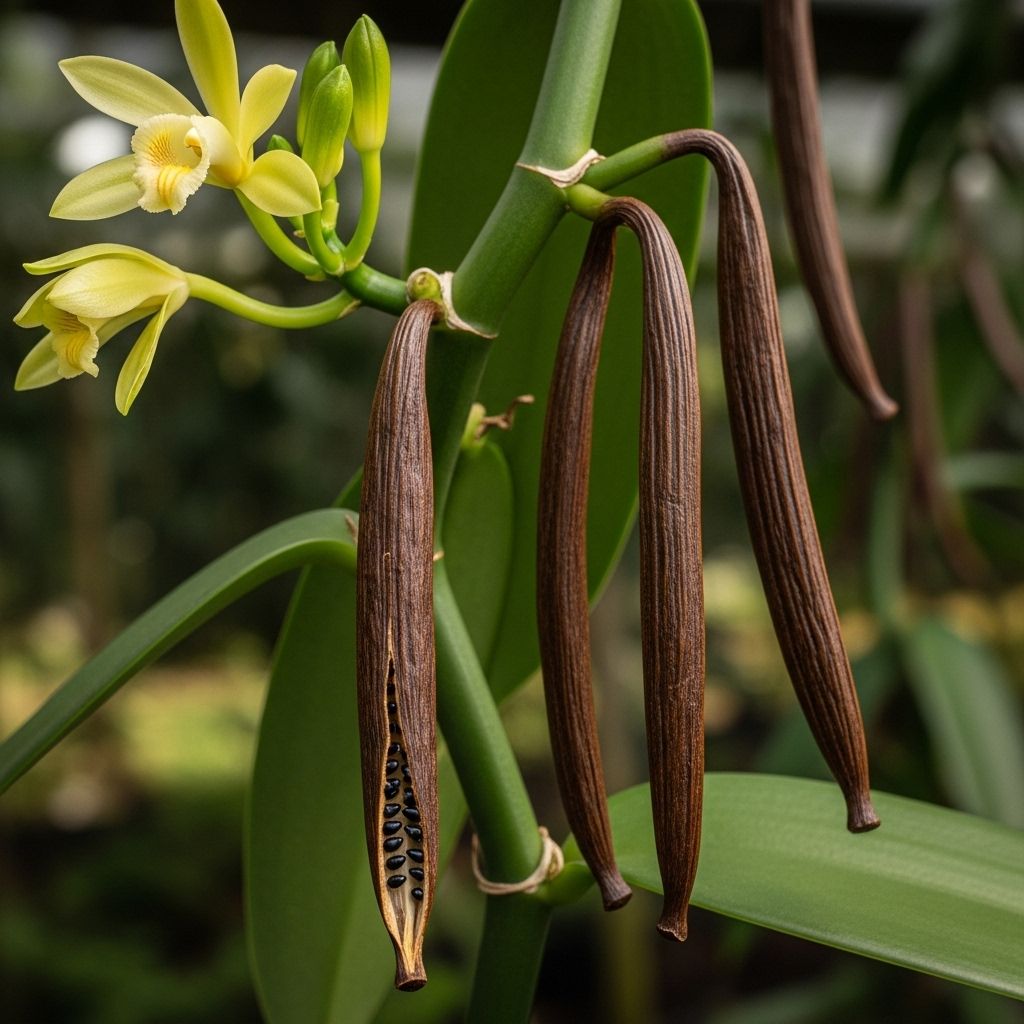Growing Vanilla
Consistent care reveals the key to thriving vines and richly aromatic pods.

Image: HearthJunction Design Team
Introduction to Growing Vanilla
Vanilla, one of the most prized spices globally, is derived from the pods of the Vanilla planifolia or Vanilla tahitensis orchids. These plants are native to the hot and humid climates of tropical regions, making them quite challenging to cultivate in non-tropical environments. However, with the right conditions and care, anyone can grow vanilla orchids, even in a controlled greenhouse setting. This guide will walk you through the steps to successfully cultivate vanilla at home.
Quick Care Guide for Vanilla Plants
To ensure your vanilla orchid thrives, it’s essential to understand its basic needs. Here’s a quick overview of the care requirements:
| Common Name(s) | Scientific Name | Days to Harvest | Light | Water | Soil | Fertilizer | Pests | Diseases |
|---|---|---|---|---|---|---|---|---|
| Vanilla, Vanilla Orchid, Flat-Leaf Vanilla, West Indian Vanilla | Vanilla planifolia or Vanilla tahitensis | 180 to 270 days | Indirect Sunlight | Consistent, Light | Combo Bark, Peat Moss, Well-Draining | High Nitrogen when Active, Full-Spectrum Balanced when Dormant | Spider Mites, Mealybugs | Root Rot, Stem Rot |
Planting Vanilla
Planting vanilla requires careful consideration of the environment and the specific needs of the plant. While vanilla orchids thrive in tropical conditions, they can be grown in other regions with proper care:
- Indirect Sunlight: Vanilla plants need indirect sunlight, especially in the morning and evening, and bright filtered shade in the afternoon. Direct sunlight can be harmful, especially in warmer climates.
- Support System: Vanilla orchids are climbing plants and need a support system such as a pole or stake to grow upwards.
- Soil and Potting Mix: Use a well-draining potting mix specifically designed for orchids, combining bark and peat moss. Ensure the container has adequate drainage holes to prevent waterlogging.
- Pruning and Training: Before planting, trim about a third of the roots to encourage new root growth. Then, plant the vanilla orchid in its pot, securing it to the support system.
Vanilla Plant Care
Once your vanilla orchid is planted, maintaining the right conditions is crucial for its health and productivity:
- Watering: Vanilla plants require consistent, light watering. Avoid overwatering, as this can lead to root rot.
- Fertilization: Use a high-nitrogen fertilizer during the active growing season and a balanced fertilizer during the dormant period.
- Humidity and Temperature: Vanilla orchids thrive in humid environments with temperatures between 65°F and 85°F (18°C and 30°C).
- Pest Control: Regularly inspect your plants for pests like spider mites and mealybugs, treating them promptly if found.
Pollination and Harvest
Vanilla plants require manual pollination to produce pods. This is a delicate process that involves using a tool like a toothpick or blade of grass to transfer pollen from the anther to the stigma when the flower opens.
After successful pollination, it takes about 9 months for the pods to mature. Harvest them when they are yellowish-green and not quite ripe, as they will turn black and develop their characteristic flavor and aroma during the curing process.
Curing Vanilla Beans
Curing vanilla beans involves a multi-step process that converts the green, unflavored pods into the aromatic, flavorful beans used in cooking and baking:
- Initial Drying: Place the harvested pods in hot water for a few minutes to stop the ripening process, then dry them in the sun or using a controlled heating method.
- Sweating: Wrap the dried pods in cloth and let them ‘sweat’ for several days. This process helps develop the vanillin flavor.
- Final Drying: Once the pods have sweated, dry them further to remove excess moisture, resulting in the dark, aromatic vanilla beans.
Challenges and Tips for Growing Vanilla
Growing vanilla can be challenging due to its specific needs and the manual pollination required. Here are some tips to help overcome common challenges:
- Use a Greenhouse: If you live outside a tropical region, growing vanilla in a greenhouse can provide the necessary conditions.
- Monitor for Pests and Diseases: Regularly inspect your plants for signs of pests or diseases like root rot and take action promptly.
- Provide Adequate Support: Ensure your vanilla orchid has a sturdy support system to climb on.
Frequently Asked Questions (FAQs)
Q: Can I grow vanilla in a non-tropical climate?
A: Yes, you can grow vanilla in non-tropical climates by using a greenhouse or a controlled indoor environment that mimics tropical conditions.
Q: How often should I water my vanilla orchid?
A: Water your vanilla orchid lightly but consistently, ensuring the potting mix is moist but not waterlogged.
Q: Why is my vanilla orchid not producing flowers?
A: If your vanilla orchid is not producing flowers, it may be due to inadequate light, insufficient fertilization, or a lack of support. Adjusting these factors can help induce flowering.
Q: How do I pollinate my vanilla orchid?
A: Pollinate your vanilla orchid by using a toothpick or a blade of grass to transfer pollen from the anther to the stigma when the flower opens.
References
Grow Vanilla Beans at Home: Step-by-Step Guide
Watch now to discover how to grow vanilla orchids at home. Learn ideal light, humidity, hand-pollination and harvest tips for lush vines and flavorful vanilla beans. Dive in and learn!
Read full bio of Srija Burman












